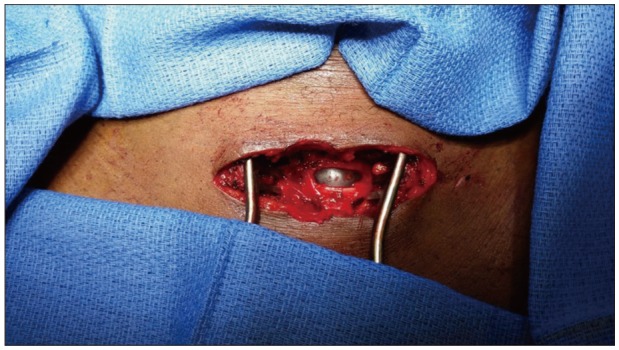Abstract
Spinal cord injuries are debilitating and life threatening. Paraplegia due to direct traumatic gunshot injury to the spinal cord is common. The most common cause of spinal cord injury is road traffic accidents. This is followed by spinal cord injury due to a fall from a height. Most of the spinal cord injuries due to gunshot wounds occur as a result of direct traumatic effects. We present a rare case of a 49-year-old male with trauma. He developed paraplegia after a gunshot wound injury to the neck and contusion to the spinal cord, with no direct trauma. Paraplegia due to direct gunshot injury can have many different outcomes. In our case, the patient was managed conservatively, and the outcome was favorable.
Go to : 
Penetrating trauma account for 13% to 17% of all spinal injuries.12) The most common cause of spinal cord injury is road traffic accident followed by a fall from a height. Gunshot injuries constitute the 3rd most common cause of spinal cord injury in United States of America.3) Most of the spinal cord injuries due to gunshot wounds occur as a result of direct traumatic effects. We present a rare care of spinal cord injury following an indirect gunshot wound to the neck resulting in paraplegia.
Go to : 
A 49 year-old male presented to the emergency room after sustaining a gunshot wound to the left anterior neck with bullet exiting through the right suprascapular region. The patient sustained a tracheal injury with air escaping through the traumatic tracheostomy (Figure 1). Primary survey was significant for right pneumothorax and bilateral lower extremity paresis. The patient was intubated and computed tomography (CT) scan of the brain, CT angiogram of the neck were performed to rule out vascular injury. CT scan revealed T1 transverse process fracture. Patient was taken to the operative room for exploration. No other obvious injuries were found. Esophageal injury was ruled out via endoscopy. During the early postoperative period, the patient became increasingly weak in all four extremities, especially the legs. Magnetic resonance imaging (MRI) showed signal abnormality around T1-T2 region consistent with spinal cord contusion (Figure 2). Patient was managed conservatively. Throughout his hospital course, he was engaged in intense rehabilitation process which led to improvement in his bilateral lower extremity weakness. Patient was transferred to the acute rehab facility where paraplegia was almost resolved with only mild residual weakness. On follow up patient was doing well with no residual weakness.
Go to : 
Spinal cord injury after a gunshot wound usually occurs due to direct trauma resulting in transection, contusion, vascular injury and ischemia associated with bone and soft tissue injuries. Also, high velocity gunshot wounds have large energy of distribution that can have an indirect negative effect on the vascular supply of the spinal cord. In such cases, kinetic energy is dissipated into the surrounding tissues disrupting tissues distant from the direct track of the bullet. This results in microvascular injury leading to contusion.4) The kinetic injury depends on the mass, the velocity of the projectile, and the physical properties of the bullet. Spinal cord can also be damaged by the low energy shock waves that penetrates through its bony protection.5) If there is whiplash injury that is suspected after a gunshot wound slipping, the bullet velocity or hyper-extension injury of the cervicothoracic junction can occur. When whiplash injury is suspected, you would note enhancements of the MRI, then higher symptoms are typical.
Mirovsky et al.8), in a retrospective review of patients with neurologic deficits following a gunshot wound admitted between 1977 and 2003 found only 3 patients with deficits without canal compromise. They had no neurologic recovery at 4 year follow up. Goonewardene et al.5) reported a case of delayed tetraplegia in a 31 year old male who sustained gunshot injury to the neck. Patient had a fracture of the spinous process of C5 with no direct spinal cord injury. Similarly, Klack et al.6) described a case of complete paraplegia following gunshot wound to the abdomen with bullet's trajectory close to the spinal cord without direct trauma.
Our patient sustained a gunshot injury to the left anterior neck with tracheal injury resulting in paraplegia without direct contact with the spinal cord. The bullet's track did not have a direct contact with the spinal cord. MRI later confirmed the spinal cord injury to be due to T1 contusion of the spinal cord. In addition it also showed that anterior soft tissue swelling from C7 to T4. However our patient did develop four extremities weakness in the post-operative period, one explanation is that the contusion was evolving and patient are known to have symptoms typical of a higher level early post injury and those symptoms tend to improve with time and rehabilitation, as it did in our patient.
Gunshot injuries most commonly affect the thoracic followed by the thoracolumbar and cervical regions.7) Although T1-T2 is the relatively stable segment, but patient can develop paraparesis after indirect bullet wound to anterior neck in thoracic region. One explanation would be that the bony segment which is stable can suffer contusion from the kinetic energy transferred from the bullet's velocity leading to lower extremity weakness. Patients with cervical spine injury carry a poor prognosis for neurologic recovery and are at risk for sudden death.8)
The treatment of the spinal injury varies widely. Some advocate steroids, but review of the most recent literature shows no benefits of steroids for neurologic recovery, rather are associated with increased risk of infection and immune compromise.9) In patients with spinal cord injury from an indirect gunshot wound, mechanical stabilization is not needed since there are no bony injuries. Full recovery is difficult in patients with cervical or thoracic canal violation, but possible in patients with cord contusion following its resolution.10) In these cases, conservative management with treatment focused mainly on early rehabilitation and occupational therapy can improve the outcome.
Go to : 
Neurologic deficit following an indirect high velocity gunshot wound is possible due to the effect of bullet's large energy of distribution on spinal cord resulting in contusion. Knowing this mechanism can help in better understanding the course of the disease process and its prognosis.
Go to : 
References
1. Chittiboina P, Banerjee AD, Zhang S, Caldito G, Nanda A, Willis BK. How bullet trajectory affects outcomes of civilian gunshot injury to the spine. J Clin Neurosci. 2011; 18:1630–1633. PMID: 22001241.

2. de Barros Filho TE, Cristante AF, Marcon RM, Ono A, Bilhar R. Gunshot injuries in the spine. Spinal Cord. 2014; 52:504–510. PMID: 24777161.

3. Devivo MJ. Epidemiology of traumatic spinal cord injury: trends and future implications. Spinal Cord. 2012; 50:365–372. PMID: 22270188.

4. Farmer JC, Vaccaro AR, Balderston RA, Albert TJ, Cotler J. The changing nature of admissions to a spinal cord injury center: violence on the rise. J Spinal Disord. 1998; 11:400–403. PMID: 9811100.
5. Goonewardene SS, Mangat KS, Sargeant ID, Porter K, Greaves I. Tetraplegia following cervical spine cord contusion from indirect gunshot injury effects. J R Army Med Corps. 2007; 153:52–53. PMID: 17575878.

6. Klack F, Tassin C, Cotton F, Luaute J, Gauthier J, David JS. Gunshot injury without direct injury to the cord may lead to complete paraplegia. Eur J Trauma Emerg Surg. 2011; 37:49–51. PMID: 26814750.

7. le Roux JC, Dunn RN. Gunshot injuries of the spine-a review of 49 cases managed at the Groote Schuur Acute Spinal Cord Injury Unit. S Afr J Surg. 2005; 43:165–168. PMID: 16440591.
8. Mirovsky Y, Shalmon E, Blankstein A, Halperin N. Complete paraplegia following gunshot injury without direct trauma to the cord. Spine (Phila Pa 1976). 2005; 30:2436–2438. PMID: 16261122.

9. Secer M, Ulutaş M, Yayla E, Cinar K. Upper cervical spinal cord gunshot injury without bone destruction. Int J Surg Case Rep. 2014; 5:149–151. PMID: 24566426.
10. Sidhu GS, Ghag A, Prokuski V, Vaccaro AR, Radcliff KE. Civilian gunshot injuries of the spinal cord: a systematic review of the current literature. Clin Orthop Relat Res. 2013; 471:3945–3955. PMID: 23479233.

Go to : 




 PDF
PDF ePub
ePub Citation
Citation Print
Print




 XML Download
XML Download